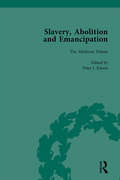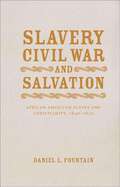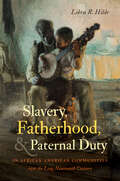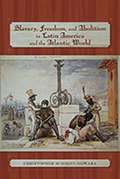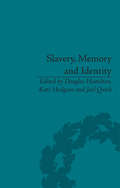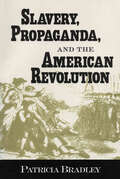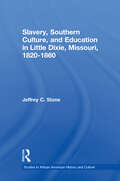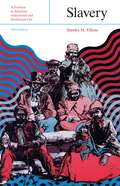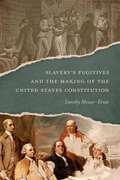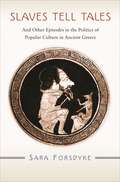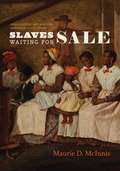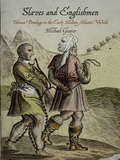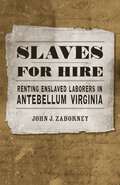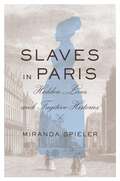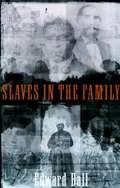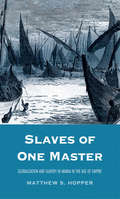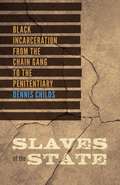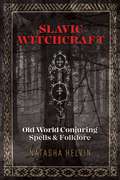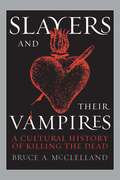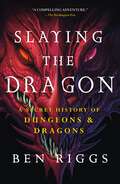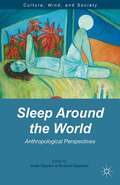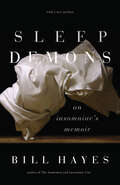- Table View
- List View
Slavery, Abolition and Emancipation Vol 2: Writings In The British Romantic Period
by James Walvin Debbie Lee Peter J Kitson Anne K MellorMost writers associated with the first generation of British Romanticism - Blake, Coleridge, Wordsworth, Southey, Thelwall, and others - wrote against the slave trade. This edition collects a corpus of work which reflects the issues and theories concerning slavery and the status of the slave.
Slavery, Civil War, and Salvation: African American Slaves and Christianity, 1830-1870 (Conflicting Worlds: New Dimensions of the American Civil War)
by Daniel L. FountainDuring the Civil War, traditional history tells us, Afro-Christianity proved a strong force for slaves' perseverance and hope of deliverance. In Slavery, Civil War, and Salvation, however, Daniel Fountain raises the possibility that Afro-Christianity played a less significant role within the antebellum slave community than most scholars currently assert. Bolstering his argument with a quantitative survey of religious behavior and WPA slave narratives, Fountain presents a new timeline for the African American conversion experience.Both the survey and the narratives reveal that fewer than 40 percent of individuals who gave a datable conversion experience had become Christians prior to acquiring freedom. Fountain pairs the survey results with an in-depth examination of the obstacles within the slaves' religious landscape that made conversion more difficult if not altogether unlikely, including infrequent access to religious instruction, the inconsistent Christian message offered to slaves, and the slaves' evolving religious identity. Furthermore, he provides other possible explanations for beliefs that on the surface resembled Christianity but in fact adhered to traditional African religions. Fountain maintains that only after emancipation and the fulfillment of the predicted Christian deliverance did African Americans more consistently turn to Christianity. Freedom, Fountain contends, brought most former slaves into the Christian faith. Provocative and enlightening, Slavery, Civil War, and Salvation redefines the role of Christianity within the slave community.
Slavery, Fatherhood, and Paternal Duty in African American Communities over the Long Nineteenth Century (The John Hope Franklin Series in African American History and Culture)
by Libra R. HildeAnalyzing published and archival oral histories of formerly enslaved African Americans, Libra R. Hilde explores the meanings of manhood and fatherhood during and after the era of slavery, demonstrating that black men and women articulated a surprisingly broad and consistent vision of paternal duty across more than a century. Complicating the tendency among historians to conflate masculinity within slavery with heroic resistance, Hilde emphasizes that, while some enslaved men openly rebelled, many chose subtle forms of resistance in the context of family and local community. She explains how a significant number of enslaved men served as caretakers to their children and shaped their lives and identities. From the standpoint of enslavers, this was particularly threatening--a man who fed his children built up the master's property, but a man who fed them notions of autonomy put cracks in the edifice of slavery. Fatherhood highlighted the agonizing contradictions of the condition of enslavement, and to be an involved father was to face intractable dilemmas, yet many men tried. By telling the story of the often quietly heroic efforts that enslaved men undertook to be fathers, Hilde reveals how formerly enslaved African Americans evaluated their fathers (including white fathers) and envisioned an honorable manhood.
Slavery, Freedom, and Abolition in Latin America and the Atlantic World
by Christopher Schmidt-NowaraThe last New World countries to abolish slavery were Cuba and Brazil, more than twenty years after slave emancipation in the United States. Why slavery was so resilient and how people in Latin America fought against it are the subjects of this compelling study. Beginning with the roots of African slavery in the fifteenth- and sixteenth-century Iberian empires, this work explores central issues, including the transatlantic slave trade, labor, Afro-Latin American cultures, racial identities in colonial slave societies, and the spread of antislavery ideas and social movements. A study of Latin America, this work, with its Atlantic-world framework, will also appeal to students of slavery and abolition in other Atlantic empires and nation-states in the early modern and modern eras.
Slavery, Memory and Identity: National Representations and Global Legacies
by Joel Quirk Douglas Hamilton Kate HodgsonThis is the first book to explore national representations of slavery in an international comparative perspective. Contributions span a wide geographical range, covering Europe, North America, West and South Africa, the Indian Ocean and Asia.
Slavery, Propaganda, and the American Revolution
by Patricia BradleyUnder the leadership of Samuel Adams, patriot propagandists deliberately and conscientiously kept the issue of slavery off the agenda as goals for freedom were set for the American Revolution. By comparing coverage in the publications of the patriot press with those of the moderate colonial press, this book finds that the patriots avoided, misinterpreted, or distorted news reports on blacks and slaves, even in the face of a vigorous antislavery movement. The Boston Gazette, the most important newspaper of the Revolution, was chief among the periodicals that dodged or excluded abolition. The author of this study shows that The Gazette misled its readers about the notable Somerset decision that led to abolition in Great Britain. She notes also that The Gazette excluded anti-slavery essays, even from patriots who supported abolition. No petitions written by Boston slaves were published, nor were any writings by the black poet Phillis Wheatley. The Gazette also manipulated the racial identity of Crispus Attucks, the first casualty in the Revolution. When using the word slavery, The Gazette took care to focus it not upon abolition but upon Great Britain's enslavement of its American colonies. Since propaganda on behalf of the Revolution reached a high level of sophistication, and since Boston can be considered the foundry of Revolutionary propaganda, the author writes that the omission of abolition from its agenda cannot be considered as accidental but as intentional. By the time the Revolution began, white attitudes toward blacks were firmly fixed, and these persisted long after American independence had been achieved. In Boston, notions of virtue and vigilance were shown to be negatively embodied in black colonists. These devil's imps were long represented in blackface in Boston's annual Pope Day parade. Although the leaders of the Revolution did not articulate a national vision on abolition, the colonial anti-slavery movement was able to achieve a degree of success, but only in drives through the individual colonies.
Slavery, Race, and Conquest in the Tropics
by Robert E. MaySlavery, Race, and Conquest in the Tropics challenges the way historians interpret the causes of the American Civil War. Using Abraham Lincoln and Stephen Douglas's famed rivalry as a prism, Robert E. May shows that when Lincoln and fellow Republicans opposed slavery in the West, they did so partly from evidence that slaveholders, with Douglas's assistance, planned to follow up successes in Kansas by bringing Cuba, Mexico, and Central America into the Union as slave states. A skeptic about 'Manifest Destiny', Lincoln opposed the war with Mexico, condemned Americans invading Latin America, and warned that Douglas's 'popular sovereignty' doctrine would unleash US slaveholders throughout Latin America. This book internationalizes America's showdown over slavery, shedding new light on the Lincoln-Douglas rivalry and Lincoln's Civil War scheme to resettle freed slaves in the tropics.
Slavery, Southern Culture, and Education in Little Dixie, Missouri, 1820-1860 (Studies in African American History and Culture)
by Jeffrey C. StoneThis dissertation examines the cultural and educational history of central Missouri between 1820 and 1860, and in particular, the issue of master-slave relationships and how they affected education (broadly defined as the transmission of Southern culture). Although Missouri had one of the lowest slave populations during the Antebellum period, Central Missouri - or what became known as Little Dixie - had slave percentages that rivaled many regions and counties of the Deep South. However, slaves and slave owners interacted on a regular basis, which affected cultural transmission in the areas of religion, work, and community. Generally, slave owners in Little Dixie showed a pattern of paternalism in all these areas, but the slaves did not always accept their masters' paternalism, and attempted to forge a life of their own.
Slavery: A Problem in American Institutional and Intellectual Life
by Stanley M. ElkinsThis third edition of Stanley M. Elkin's classic study offers two new chapters by the author. The first, "Slavery and Ideology," considers the discussion and criticism occasioned by this controversial work. Elkins amplifies his original purpose in writing the book and takes into consideration the substantial body of critical commentary. He also attempts a prediction on the course of future research and discussion.
Slavery’s Fugitives and the Making of the United States Constitution
by Timothy Messer-KruseSlavery’s Fugitives and the Making of the United States Constitution unearths a long-hidden factor that led to the Constitutional Convention in 1787. While historians have generally acknowledged that patriot leaders assembled in response to postwar economic chaos, the threat of popular insurgencies, and the inability of the states to agree on how to fund the national government, Timothy Messer-Kruse suggests that scholars have discounted Americans’ desire to compel Britain to return fugitives from slavery as a driving force behind the convention.During the Revolutionary War, British governors offered freedom to enslaved Americans who joined the king’s army. Thousands responded by fleeing to English camps. After the British defeat at Yorktown, American diplomats demanded the surrender of fugitive slaves. When British generals refused, several states confiscated Loyalist estates and blocked payment of English creditors, hoping to apply enough pressure on the Crown to hand over the runaways. State laws conflicting with the 1783 Treaty of Paris violated the Articles of Confederation—the young nation’s first constitution—but Congress, lacking an executive branch or a federal judiciary, had no means to obligate states to comply. The standoff over the escaped slaves quickly escalated following the Revolution as Britain failed to abandon the western forts it occupied and took steps to curtail American commerce. More than any other single matter, the impasse over the return of enslaved Americans threatened to hamper the nation’s ability to expand westward, develop its commercial economy, and establish itself as a power among the courts of Europe. Messer-Kruse argues that the issue encouraged the founders to consider the prospect of scrapping the Articles of Confederation and drafting a superseding document that would dramatically increase federal authority—the Constitution.
Slaves Tell Tales: And Other Episodes in the Politics of Popular Culture in Ancient Greece
by Sara ForsdykeMost studies of ancient Greek politics focus on formal institutions such as the political assembly and the law courts, and overlook the role that informal social practices played in the regulation of the political order. Sara Forsdyke argues, by contrast, that various forms of popular culture in ancient Greece--including festival revelry, oral storytelling, and popular forms of justice--were a vital medium for political expression and played an important role in the negotiation of relations between elites and masses, as well as masters and slaves, in the Greek city-states. Although these forms of social life are only poorly attested in the sources, Forsdyke suggests that Greek literature reveals traces of popular culture that can be further illuminated by comparison with later historical periods. By looking beyond institutional contexts, moreover, Forsdyke recovers the ways that groups that were excluded from the formal political sphere--especially women and slaves--participated in the process by which society was ordered. Forsdyke begins each chapter with an apparently marginal incident in Greek history--the worship of a dead slave by masters on Chios, the naming of Sicyon's civic divisions after lowly animals such as pigs and asses, and the riding of an adulteress on a donkey through the streets of Cyme--and shows how these episodes demonstrate the significance of informal social practices and discourses in the regulation and reproduction of the social order. The result is an original, fascinating, and enlightening new perspective on politics and popular culture in ancient Greece.
Slaves Waiting for Sale
by Maurie D. McinnisIn 1853, Eyre Crowe, a young British artist, visited a slave auction in Richmond, Virginia. Harrowed by what he witnessed, he captured the scene in sketches that he would later develop into a series of illustrations and paintings, including the culminating painting, Slaves Waiting for Sale, Richmond, Virginia. This innovative book uses Crowe's paintings to explore the texture of the slave trade in Richmond, Charleston, and New Orleans, the evolving iconography of abolitionist art, and the role of visual culture in the transatlantic world of abolitionism. Tracing Crowe's trajectory from Richmond across the American South and back to London--where his paintings were exhibited just a few weeks after the start of the Civil War--Maurie D. McInnis illuminates not only how his abolitionist art was inspired and made, but also how it influenced the international public's grasp of slavery in America. With almost 140 illustrations, Slaves Waiting for Sale brings a fresh perspective to the American slave trade and abolitionism as we enter the sesquicentennial of the Civil War.
Slaves and Englishmen
by Michael GuascoTechnically speaking, slavery was not legal in the English-speaking world before the mid-seventeenth century. But long before race-based slavery was entrenched in law and practice, English men and women were well aware of the various forms of human bondage practiced in other nations and, in less systematic ways, their own country. They understood the legal and philosophic rationale of slavery in different cultural contexts and, for good reason, worried about the possibility of their own enslavement by foreign Catholic or Muslim powers. While opinions about the benefits and ethics of the institution varied widely, the language, imagery, and knowledge of slavery were a great deal more widespread in early modern England than we tend to assume.In wide-ranging detail, Slaves and Englishmen demonstrates how slavery shaped the ways the English interacted with people and places throughout the Atlantic world. By examining the myriad forms and meanings of human bondage in an international context, Michael Guasco illustrates the significance of slavery in the early modern world before the rise of the plantation system or the emergence of modern racism. As this revealing history shows, the implications of slavery were closely connected to the question of what it meant to be English in the Atlantic world.
Slaves for Hire: Renting Enslaved Laborers in Antebellum Virginia
by John J. ZaborneyIn Slaves for Hire, John J. Zaborney overturns long-standing beliefs about slave labor in the antebellum South. Previously, scholars viewed slave hiring as an aberration -- a modified form of slavery, involving primarily urban male slaves, that worked to the laborer's advantage and weakened slavery's institutional integrity. In the first in-depth examination of slave hiring in Virginia, Zaborney suggests that this endemic practice bolstered the institution of slavery in the decades leading up to the Civil War, all but assuring Virginia's secession from the Union to protect slavery.Moving beyond previous analyses, Zaborney examines slave hiring in rural and agricultural settings, along with the renting of women, children, and elderly slaves. His research reveals that, like non-hired-out slaves, these other workers' experiences varied in accordance with sex, location, occupation, economic climate, and crop prices, as well as owners' and renters' convictions and financial circumstances. Hired slaves in Virginia faced a full range of oppression from nearly full autonomy to harsh exploitation.Whites of all economic, occupational, gender, ethnic, and age groups, including slave owners and non-slave-owners, rented slaves regularly. Additionally, male owners and hirers often transported slaves to those who worked them, and acted as agents for white women who wished to hire out their slaves. Ultimately, widespread white mastery of hired slaves allowed owners with superfluous slaves to offer them for rent locally rather than selling them to the Lower South, establishing the practice as an integral feature of Virginia slavery.
Slaves in Paris: Hidden Lives and Fugitive Histories
by Miranda SpielerA pioneering biographical study of enslaved people and their struggle for freedom in prerevolutionary Paris, by an award-winning historian of France and the French Empire.In the decades leading up to the French Revolution, when Paris was celebrated as an oasis of liberty, slaves fled there, hoping to be freed. They pictured Paris as a refuge from France’s notorious slave-trading ports.The French were late to the slave trade, but they dominated the global market in enslaved people by the late 1780s. This explosive growth transformed Paris, the cultural capital of the Enlightenment, into a dangerous place for people in bondage. Those seeking freedom in Paris faced manhunts, arrest, and deportation. Some put their faith in lawyers, believing the city’s courts would free them. Examining the lives of those whose dashed hopes and creative persistence capture the spirit of the era, Miranda Spieler brings to light a hidden story of slavery and the struggle for freedom.Fugitive slaves collided with spying networks, nosy neighbors, and overlapping judicial authorities. Their clandestine lives left a paper trail. In a feat of historical detective work, Spieler retraces their steps and brings to light the new racialized legal culture that permeated every aspect of everyday life. She pieces together vivid, granular portraits of men, women, and children who came from Africa, the Caribbean, and the Indian Ocean. We learn of their strategies and hiding places, their family histories and relationships to well-known Enlightenment figures. Slaves in Paris is a history of hunted people. It is also a tribute to their resilience.
Slaves in the Family
by Edward BallThe Ball family hails from South Carolina―Charleston and thereabouts. Their plantations were among the oldest and longest-standing plantations in the South. Between 1698 and 1865, close to four thousand black people were born into slavery under the Balls or were bought by them. In Slaves in the Family, Edward Ball recounts his efforts to track down and meet the descendants of his family's slaves. Part historical narrative, part oral history, part personal story of investigation and catharsis, Slaves in the Family is, in the words of Pat Conroy, "a work of breathtaking generosity and courage, a magnificent study of the complexity and strangeness and beauty of the word ‘family.'"<P><P> Winner of the National Book Award
Slaves of One Master
by Matthew S. HopperIn this wide-ranging history of the African diaspora and slavery in Arabia in the nineteenth and early twentieth centuries, Matthew S. Hopper examines the interconnected themes of enslavement, globalization, and empire and challenges previously held conventions regarding Middle Eastern slavery and British imperialism. Whereas conventional historiography regards the Indian Ocean slave trade as fundamentally different from its Atlantic counterpart, Hopper's study argues that both systems were influenced by global economic forces. The author goes on to dispute the triumphalist antislavery narrative that attributes the end of the slave trade between East Africa and the Persian Gulf to the efforts of the British Royal Navy, arguing instead that Great Britain allowed the inhuman practice to continue because it was vital to the Gulf economy and therefore vital to British interests in the region. Hopper's book links the personal stories of enslaved Africans to the impersonal global commodity chains their labor enabled, demonstrating how the growing demand for workers created by a global demand for Persian Gulf products compelled the enslavement of these people and their transportation to eastern Arabia. His provocative and deeply researched history fills a salient gap in the literature on the African diaspora.
Slaves of the State: Black Incarceration from the Chain Gang to the Penitentiary
by Dennis ChildsThe Thirteenth Amendment to the United States Constitution, passed in 1865, has long been viewed as a definitive break with the nation&’s past by abolishing slavery and ushering in an inexorable march toward black freedom. Slaves of the State presents a stunning counterhistory to this linear narrative of racial, social, and legal progress in America. Dennis Childs argues that the incarceration of black people and other historically repressed groups in chain gangs, peon camps, prison plantations, and penitentiaries represents a ghostly perpetuation of chattel slavery. He exposes how the Thirteenth Amendment&’s exception clause—allowing for enslavement as &“punishment for a crime&”—has inaugurated forms of racial capitalist misogynist incarceration that serve as haunting returns of conditions Africans endured in the barracoons and slave ship holds of the Middle Passage, on plantations, and in chattel slavery. Childs seeks out the historically muted voices of those entombed within terrorizing spaces such as the chain gang rolling cage and the modern solitary confinement cell, engaging the writings of Toni Morrison and Chester Himes as well as a broad range of archival materials, including landmark court cases, prison songs, and testimonies, reaching back to the birth of modern slave plantations such as Louisiana&’s &“Angola&” penitentiary. Slaves of the State paves the way for a new understanding of chattel slavery as a continuing social reality of U.S. empire—one resting at the very foundation of today&’s prison industrial complex that now holds more than 2.3 million people within the country&’s jails, prisons, and immigrant detention centers.
Slaves to Rome
by Myles LavanThis study in the language of Roman imperialism provides a provocative new perspective on the Roman imperial project. It highlights the prominence of the language of mastery and slavery in Roman descriptions of the conquest and subjection of the provinces. More broadly, it explores how Roman writers turn to paradigmatic modes of dependency familiar from everyday life - not just slavery but also clientage and childhood - in order to describe their authority over, and responsibilities to, the subject population of the provinces. It traces the relative importance of these different models for the imperial project across almost three centuries of Latin literature, from the middle of the first century BCE to the beginning of the third century CE.
Slavic Witchcraft: Old World Conjuring Spells and Folklore
by Natasha HelvinA practical guide to the ancient magical tradition of Russian sorcery and Eastern Slavic magical rites • Offers step-by-step instructions for more than 300 spells, incantations, charms, amulets, and practical rituals for love, career success, protection, healing, divination, communicating with spirits and ancestors, and other challenges and situations • Reveals specific places of magical power in the natural world as well as the profound power of graveyards and churches for casting spells • Explores the folk history of this ancient magical tradition, including how the pagan gods gained new life as Eastern Orthodox saints, and shares folktales of magical beings, including sorceresses shapeshifting into animals and household objects Passed down through generations, the Slavic practice of magic, witchcraft, and sorcery is still alive and well in Russia, the Ukraine, and Belarus, as well as the Balkans and the Baltic states. There are still witches who whisper upon tied knots to curse or heal, sorceresses who shapeshift into animals or household objects, magicians who cast spells for love or good fortune, and common folk who seek their aid for daily problems big and small. Sharing the extensive knowledge she inherited from her mother and grandmother, including spells of the “Old Believers” previously unknown to outsiders, Natasha Helvin explores in detail the folk history and practice of Russian sorcery and Eastern Slavic magical rites, offering a rich compendium of more than 300 spells, incantations, charms, and practical rituals for love, relationships, career success, protection, healing, divination, averting the evil eye, communicating with spirits and ancestors, and a host of other life challenges and daily situations, with complete step-by-step instructions to ensure your magical goals are realized. She explains how this tradition has only a thin Christian veneer over its pagan origins and how the Slavic pagan gods and goddesses acquired new lives as the saints of the Eastern Orthodox Church. She details how the magical energy for these spells and rituals is drawn from the forces of nature, revealing specific places of power in the natural world as well as the profound power of graveyards and churches for casting spells. She explores the creation of amulets and talismans, the importance of icons, and the proper recital of magical language and actions during spells, as well as how one becomes a witch or sorceress. Offering a close examination of these two-thousand-year-old occult practices, Helvin also includes Slavic folk advice, adapted for the modern era. Revealing what it means to be a Slavic witch or sorceress, and how this vocation pervades all aspects of life, she shows that each of us has magic within that we can use to take control of our own destiny.
Slavoj Zizek (Routledge Critical Thinkers)
by Tony MyersSlavoj Zizek is no ordinary philosopher. Approaching critical theory and psychoanalysis in a recklessly entertaining fashion, Zizek's critical eye alights upon a bewildering and exhilarating range of subjects, from the political apathy of contemporary life, to a joke about the man who thinks he's a chicken, from the ethicial heroism of Keanu Reeves in Speed, to what toilet designs reveal about the national psyche. Tony Myers provides a clear and engaging guide to Zizek's key ideas, explaining the main influences on Zizek's thought (most crucially his engagement with Lacanian psychoanalysis) using examples drawn from popular culture and everyday life. Myers outlines the key issues that Zizek's work has tackled, including: What is a Subject and why is it so important? The Imaginary, the Symbolic and the Real What is so terrible about Postmodernity? How can we distinguish reality from ideology? What is the relationship between men and women? Why is Racism always a fantasy? Slavoj Zizek is essential reading for anyone wanting to understand the thought of the critic whom Terry Eagleton has described as "the most formidably brilliant exponent of psychoanalysis, indeed of cultural theory in general, to have emerged in Europe for some decades.
Slayers and Their Vampires: A Cultural History of Killing the Dead
by Bruce A. McclellandMcClelland (PhD, Slavic Studies, U. of Virginia) traces the cultural meaning of vampire tales from their Slavic origins in the Balkans to recent television productions such as Buffy the Vampire Slayer. In doing so, he draws attention to what he sees as the equally symbolic figure of the vampire slayer and the significance of the relationship between the two. He finds the origins of the Slavic vampire in refusals to abandon pagan beliefs and rituals proscribed by the Eastern Orthodox Church, noting that this historical aspect of the vampire is implicitly present in modern times. He then traces the transformation of the vampire and the origins of the vampire slayer in the mid-eighteenth century, arguing that originally, the vampire slayer may have its origins in Central European shamanism. He later explores Western European appropriations of the vampire through scientific and Catholic perspectives and concludes with explorations of the symbology of Van Helsing in Bram Stoker's Dracula and Buffy of the above-mentioned television series. Annotation ©2006 Book News, Inc. , Portland, OR (booknews. com)
Slaying the Dragon: A Secret History of Dungeons & Dragons
by Ben RiggsRole-playing game historian Ben Riggs unveils the secret history of TSR— the company that unleashed imaginations with Dungeons & Dragons, was driven into ruin by disastrous management decisions, and then saved by their bitterest rival.Co-created by wargame enthusiasts Gary Gygax and Dave Arneson, the original Dungeons & Dragons role-playing game released by TSR (Tactical Studies Rules) in 1974 created a radical new medium: the role-playing game. For the next two decades, TSR rocketed to success, producing multiple editions of D&D, numerous settings for the game, magazines, video games, New York Times bestselling novels by Margaret Weis, Tracy Hickman, and R. A. Salvatore, and even a TV show! But by 1997, a series of ruinous choices and failed projects brought TSR to the edge of doom—only to be saved by their fiercest competitor, Wizards of the Coast, the company behind the collectible card game Magic: The Gathering.Unearthed from Ben Riggs’s own adventurous campaign of in-depth research, interviews with major players, and acquisitions of secret documents, Slaying the Dragon reveals the true story of the rise and fall of TSR. Go behind the scenes of their Lake Geneva headquarters where innovative artists and writers redefined the sword and sorcery genre, managers and executives sabotaged their own success by alienating their top talent, ignoring their customer fanbase, accruing a mountain of debt, and agreeing to deals which, by the end, made them into a publishing company unable to publish so much as a postcard.As epic and fantastic as the adventures TSR published, Slaying the Dragon is the legendary tale of the rise and fall of the company that created the role-playing game world.
Sleep Around the World
by Katie Glaskin Richard ChenhallAlthough humans slumber for approximately one third of our lives, sleep itself is vastly understudied. This volume provides a comparative frame through which we can understand the myriad ways in which sleep reflects and embodies culture as contributors examine aspects of sleep in various countries and contexts.
Sleep Demons: An Insomniac's Memoir
by Bill Hayes“A lovely weave of memory and science, great characters and compassionate humor” from the author of Sweat: A History of Exercise (Anne Lamott).We often think of sleep as mere stasis, a pause button we press at the end of each day. Yet sleep is full of untold mysteries—eluding us when we seek it too fervently, throwing us into surreal dream worlds when we don’t, sometimes even possessing our bodies so that they walk and talk without our conscious volition. Delving into the mysteries of his own sleep patterns, Bill Hayes marvels, “I have come to see that sleep itself tells a story.”An acclaimed journalist and memoirist—and partner of the late neurologist Oliver Sacks—Hayes has been plagued by insomnia his entire life. The science and mythology of sleep and sleeplessness form the backbone to Hayes’s narrative of his personal battles with sleep and how they colored his waking life, as he threads stories of fugitive sleep through memories of growing up in the closet, coming out to his Irish Catholic family, watching his friends fall ill during the early years of the AIDS crisis in San Francisco, and finding a lover. An erudite blend of science and personal narrative, Sleep Demons offers a poignant introduction to the topics for which Hayes has since become famous, including art, eros, city life, the history of medical science, and queer identity.“This intimate and beautifully written book brings scientific research alive in a heartfelt and deeply personal narrative.” —The Guardian“Memoir, history, and science come together and apart again in a book that reads very much like a dream.” —Out magazine
